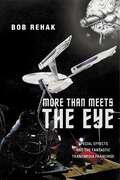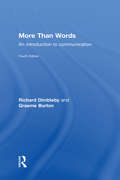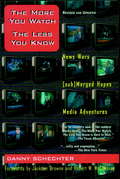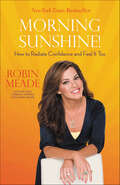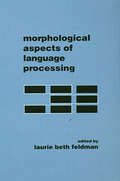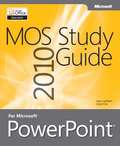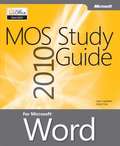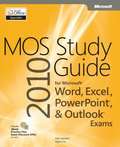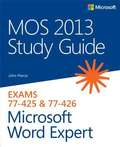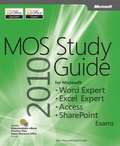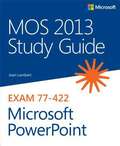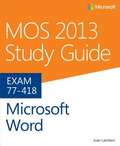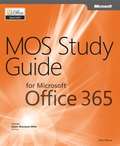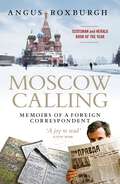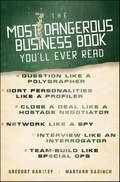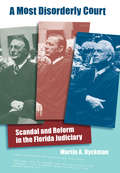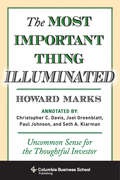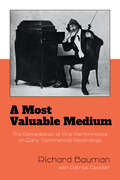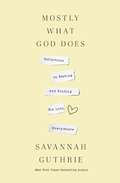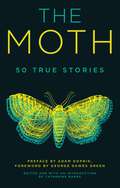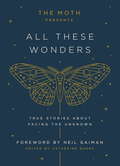- Table View
- List View
More Than Meets the Eye: Special Effects and the Fantastic Transmedia Franchise (Postmillennial Pop #19)
by Bob RehakA rare look at the role of special effects in creating fictional worlds and transmedia franchises From comic book universes crowded with soaring superheroes and shattering skyscrapers to cosmic empires set in far-off galaxies, today’s fantasy blockbusters depend on visual effects. Bringing science fiction from the studio to your screen, through film, television, or video games, these special effects power our entertainment industry. More Than Meets the Eye delves into the world of fantastic media franchises to trace the ways in which special effects over the last 50 years have become central not just to transmedia storytelling but to worldbuilding, performance, and genre in contemporary blockbuster entertainment. More Than Meets the Eye maps the ways in which special effects build consistent storyworlds and transform genres while traveling from one media platform to the next. Examining high-profile franchises in which special effects have played a constitutive role such as Star Trek, Star Wars, The Matrix, and The Lord of the Rings, as well as more contemporary franchises like Pirates of the Caribbean and Harry Potter, Bob Rehak analyzes the ways in which production practices developed alongside the cultural work of industry professionals. By studying social and cultural factors such as fan interaction, this book provides a context for understanding just how much multiplatform storytelling has come to define these megahit franchises. More Than Meets the Eye explores the larger history of how physical and optical effects in postwar Hollywood laid the foundation for modern transmedia franchises and argues that special effects are not simply an adjunct to blockbuster filmmaking, but central agents of an entire mode of production.
More Than Meow: How Cats Communicate (Fountas & Pinnell LLI Red #Level L)
by Chris BoudreauxWhat if cats could talk? Actually, they can talk, but not with words. Find out how cats use their bodies and sounds to tell you and other cats what they want and how they feel.
More Than Words: An Introduction to Communication
by Richard Dimbleby Graeme BurtonThis new edition of the best-selling text has been fully revised and updated to take into account new developments in communication and media studies. More Than Words provides an introduction to both communication theory and practice. The authors cover essential elements of communication, including communication between individuals and groups, in organizations and through mass media and new technologies.The fourth edition features:new case studies and assignmentsan updated series of key questions helping students to understand central concepts in communication studiesexpanded sections on mass media and on practical communication and media skillsguidance on listening skills, interpersonal and social skills, writing skills, leaflet design, and planning, scripting, and producing audio and video material.More Than Words is illustrated with new models and photographs and has checklist summaries for easy revision purposes. Clear and practical, it is an essential text for students of communication studies.
The More You Watch the Less You Know
by Danny Schechter Robert Mcchesney Jackson BrowneA candid insider's tale of how the media really works and why it doesn't work the way it should, The More You Watch, The Less You Know has emerged as a key catalyst in the debate on media reform. The More You Watch, The Less You Know recounts Schechter's media adventures, from when he was "Danny Schechter the News Dissector" on Boston's WBCN radio, to his stints as a producer at ABC's 20/20 and CNN, to his personal odyssey chronicling the anti-Apartheid revolution in South Africa, to his development of innovative programming like South Africa Now and Rights & Wrongs as an independent producer. In this age of telecommunications bills and media mergers, The More You Watch, The Less You Know is an insider's passionate plea for freedom of the (electronic) press.
Morning Sunshine!: How to Radiate Confidence and Feel It Too
by Robin MeadeRobin Meade is the poster child for confidence and self-assurance. But the anchor of Morning Express with Robin Meade wasn't always that way. In fact, there was a period in her career when she was plagued with anxiety and panic attacks. In MORNING SUNSHINE, she tells how she overcame her fear of public speaking to go on and achieve her dream of becoming a news anchor. Robin Meade offers her own tried-and-true four-step approach to building confidence. Her trademark warm, personal style translates from the screen to the page in this book, which will give readers even more insight into the young woman who came out of nowhere to become one of the most popular news anchors on television today.
Morphological Aspects of Language Processing
by Laurie Beth FeldmanIt is now well established that phonological -- and orthographic -- codes play a crucial role in the recognition of isolated words and in understanding the sequences of words that comprise a sentence. However, words and sentences are organized with respect to morphological as well as phonological components. It is thus unfortunate that the morpheme has received relatively little attention in the experimental literature, either from psychologists or linguists. Due to recent methodological developments, however, now is an opportune time to address morphological issues. In the experimental literature, there is a tendency to examine various psycholinguistic processes in English and then to assume that the account given applies with equal significance to English and to other languages. Written languages differ, however, in the extent to which they capture phonological as contrasted with morphological units. Moreover, with respect to the morpheme, languages differ in the principle by which morphemes are connected to form new words. This volume focuses on morphological processes in word recognition and reading with an eye toward comparing morphological processes with orthographic and phonological processes. Cross-language comparisons are examined as a tool with which to probe universal linguistic processes, and a variety of research methodologies are described. Because it makes the experimental literature in languages other than English more accessible, this book is expected to be of interest to many readers. It also directs attention to the subject of language processing in general -- an issue which is of central interest to cognitive psychologists and linguists as well as educators and clinicians.
Morson's English Guide for Court Reporters (2nd Edition)
by Lillian I. MorsonThis guide presents the fundamental rules for punctuating acceptable syntax and then goes a step further and presents verbatim English as found in courtroom transcripts and modifies the rules to accommodate this English. The grammar section and glossary offer a look at the way we name and define the elements in a sentence so that we can better understand standard word usage, spelling, and punctuation.
Mortgage Rip-offs and Money Savers: An Industry Insider Explains How to Save Thousands on Your Mortgage or Re-Finance
by Carolyn Warren&“Identifie[s] all the major dangers amateur real estate investors need to be aware of . . . many useful tips for getting the right price and the best financing.&” —Michael Masterson, New York Times–bestselling author of Automatic Wealth Mortgage Rip-offs and Money Savers reveals how the mortgage industry cheats borrowers out of billions in extra costs every year. Industry insider Carolyn Warren taps her decade of experience with lenders to expose the tricks, lies, and dirty little secrets they don&’t want you to know. With her expert guidance, borrowers will save tens of thousands when they avoid the traps so many consumers fall into. Having this inside information is the only way borrowers can truly get the best possible deal. This book presents that knowledge in an interesting and easy format that anyone can understand. Readers can void being victims of the mortgage industry with this invaluable resource. Instead, they&’ll get the best possible rates, avoid bogus fees, and get the great deal they deserve.
MOS 2010 Study Guide for Microsoft® PowerPoint®
by Joan Lambert Joyce CoxDemonstrate your expertise with Microsoft PowerPoint by earning a MOS 2010 certification. This Study Guide is designed to help you practice and prepare for Exam 77-883: PowerPoint 2010, and features: Full objective-by-objective review Procedures and hands-on practice tasks Ready-made, downloadable practice files Exam-discount Use the in-depth exam prep, practice, and review to help advance your proficiency with PowerPoint 2010--and earn the credential that proves it! NOTE: This same content is also available as part of the MOS 2010 Study Guide for Microsoft Word, Excel, PowerPoint, and Outlook Exams (ISBN 9780735648753)
MOS 2010 Study Guide for Microsoft® Word
by Joan Lambert Joyce CoxDemonstrate your expertise with Microsoft Word by earning a MOS 2010 certification. This Study Guide is designed to help you practice and prepare for Exam 77-881: Word 2010, and features:Full objective-by-objective review Procedures and hands-on practice tasks Ready-made, downloadable practice files Exam-discount Use the in-depth exam prep, practice, and review to help advance your proficiency with Word 2010--and earn the credential that proves it! NOTE: This same content is also available as part of the MOS 2010 Study Guide for Microsoft Word, Excel, PowerPoint, and Outlook Exams (ISBN 9780735648753)
MOS 2010 Study Guide for Microsoft® Word, Excel®, PowerPoint®, and Outlook®
by Joan Lambert Joyce CoxDemonstrate your expertise with Microsoft Office 2010! This all-in-one guide is designed to help you practice and prepare for the four core Microsoft Office Specialist (MOS) exams. With the MOS 2010 Study Guide, you get full, objective-by-objective coverage for: Exam 77-881: Microsoft Word 2010 Exam 77-882: Microsoft Excel 2010 Exam 77-883: Microsoft PowerPoint 2010 Exam 77-884: Microsoft Outlook 2010 Use the book's easy-to-follow procedures and illustrations to review the essential skills measured by the MOS exams. And you can apply what you've learned hands-on--using the downloadable files for all the book's practice tasks.
MOS 2010 Study Guide for Microsoft® Word Expert
by John PierceDemonstrate your expertise with Microsoft Word by earning a MOS 2010 certification. This Study Guide is designed to help you practice and prepare for Exam 77-887: Word 2010 Expert, and features:Full objective-by-objective review Procedures and hands-on practice tasks Ready-made, downloadable practice files Exam-discount Use the in-depth exam prep, practice, and review to help further advance your proficiency with Word 2010--and earn the expert-level credential that proves it! NOTE: This same content is also available as part of the MOS 2010 Study Guide for Microsoft Word Expert, Excel Expert, Access, & SharePoint Exams (ISBN 9780735657885)
MOS 2010 Study Guide for Microsoft® Word Expert, Excel® Expert, Access®, and SharePoint®
by John Pierce Geoff EvelynDemonstrate your expertise with Microsoft Office! Designed to help you practice and prepare for four Microsoft Office Specialist (MOS) exams, this all-in-one study guide features: Full, objective-by-objective exam coverage Easy-to-follow procedures and illustrations to review essential skills Hands-on practice tasks to apply what you've learned; files included Online pre-test to assess your readiness Use the in-depth exam prep, practice, and review to help advance your proficiency with Microsoft Office--and earn the credential that proves it! Exams covered: 77-887: MOS: Microsoft Office Word 2010 Expert 77-888: MOS: Microsoft Office Excel 2010 Expert 77-885: MOS: Microsoft Office Access 2010 77-886: MOS: Microsoft SharePoint 2010 Companion Content includes: Practice files for each exam Fully searchable eBook Sample chapters from five STEP BY STEP books from Microsoft Press (TBD) Additional eBooks and resources Special Offer: Exam discount plus free online pre-test! Get 25% off your MOS exam fee and a free Microsoft Official Pre-Test from Certiport Use the pre-test to assess your skill level and get feedback on your results, including a custom learning plan See details on the Certiport offer page inside
MOS 2013 Study Guide for Microsoft PowerPoint
by Joan LambertDemonstrate your expertise with Microsoft Office! Designed to help you practice and prepare for the 2013 PowerPoint Microsoft Office Specialist (MOS) exam, this all-in-one study guide features: Full, objective-by-objective exam coverage Easy-to-follow procedures and illustrations to review essential skills Hands-on practice tasks to apply what you've learned; files included Use the in-depth exam prep, practice, and review to help advance your proficiency with Microsoft Office--and earn the credential that proves it!
MOS 2013 Study Guide for Microsoft Word
by Joan LambertDemonstrate your expertise with Microsoft Office! Designed to help you practice and prepare for the 2013 Word Microsoft Office Specialist (MOS) exam, this all-in-one study guide features: Full, objective-by-objective exam coverage Easy-to-follow procedures and illustrations to review essential skills Hands-on practice tasks to apply what you've learned; files included Use the in-depth exam prep, practice, and review to help advance your proficiency with Microsoft Office--and earn the credential that proves it!
MOS Study Guide for Microsoft® Office 365
by John PierceDemonstrate your expertise with Microsoft Office 365 by earning a MOS certification. This Study Guide is designed to help you prepare for MOS Exam 77-891: Microsoft Office 365, and features:Full objective-by-objective review Easy-to-follow procedures and hands-on tasks Exam-discount offer from Certiport Use the in-depth exam prep, practice, and review to help advance your proficiency with Office 365--and earn the credential that proves it.
Moscow Calling: Memoirs of a Foreign Correspondent
by Angus RoxburghA British journalist offers an intimate view of Russia from the Cold War to the rise of Putin through his personal experiences as a correspondent. In the course of the past 45 years, Angus Roxburgh has translated Tolstoy, met four successive Russian presidents and been jinxed by a Siberian shaman. He has come under fire in war zones and been arrested by Chechen thugs. During the Cold War he was wooed by the KGB, who then decided he would make a lousy spy and expelled him from the country. In Moscow Calling, Roxburgh presents his Russia: not the Russia of news reports, but a quirky, exasperating, beautiful, tumultuous world that in four decades has changed completely—and not at all. Roxburgh narrates an incredible journey from the dark, fearful days of communism and his adventures as a correspondent covering the Soviet Union&’s collapse to his frustrating work as a media consultant to Putin&’s Kremlin. His memoir offers a unique, fascinating and at times hilarious insight into a country that today, more than ever, is of global political significance.
The Most Dangerous Business Book You'll Ever Read
by Maryann Karinch Gregory HartleyHone your professional approach to a razor's edge using lessons from military and civilian intelligenceThe Most Dangerous Business Book You'll Ever Read brings expertise from military and civilian intelligence operations into your business life. It lays out hard-hitting interpersonal skills to raise your level of professional effectiveness and vanquish your competition.The Most Dangerous Business Book You'll Ever Read features former Army interrogator Gregory Hartley's unique system of profiling, formula for persuasion, and framework for establishing expertise quickly. Gregory makes his system concrete with case studies, tables, diagrams, and more.Question like a Polygrapher Sort Personalities like a Profiler Close a Deal like a Hostage Negotiator Interview like an Interrogator Network like a Spy Research like an Intelligence Analyst Decide like a SEAL Team-Build like Special Ops Take your career focus to the next level. Discover the skills they don't teach in business school with The Most Dangerous Business Book You'll Ever Read.
A Most Disorderly Court: Scandal and Reform in the Florida Judiciary (Florida History and Culture)
by Martin A. DyckmanIn the 1970s, justices on the Florida Supreme Court were popularly elected. But a number of scandals threatened to topple the court until public outrage led to profound reforms and fundamental changes in the way justices were seated.One justice abruptly retired after being filmed on a high-roller junket to Las Vegas. Two others tried to fix cases in lower courts on behalf of campaign supporters. A fourth destroyed evidence by shredding his copy of a document into "seventeen equal" strips of paper that he then flushed down a toilet.As the journalist who wrote most of the stories that exposed these events, Martin Dyckman played a key role in revealing the corruption, favoritism, and cronyism then rampant in the court.A Most Disorderly Court recounts this dark period in Florida politics, when stunning revelations regularly came to light. He also traces the reform efforts that ultimately led to a constitutional amendment providing for the appointment of all Florida's appellate judges, and emphasizes the absolute importance of confidential sources for journalists.
The Most Famous Writer Who Ever Lived: A True Story of My Family
by Tom ShroderAn award-winning veteran of The Washington Post and The Miami Herald, Tom Shroder has made a career of investigative journalism and human-interest stories, from those of children who claim to have memories of past lives, in his book Old Souls, to that of a former Marine suffering from debilitating PTSD and his doctor pioneering a successful psychedelic drug treatment in Acid Test. Shroder's most fascinating subject, however, comes from within his own family: his grandfather MacKinlay Kantor was the world-famous author of Andersonville, the seminal novel about the Civil War. As a child, Shroder was in awe of his grandfather's larger-than-life character. Kantor's friends included Ernest Hemingway, Carl Sandburg, Gregory Peck, and James Cagney. He was an early mentor to the novelist John D. MacDonald and is credited with discovering the singer Burl Ives. Kantor wrote the novel Glory for Me, which became the multi-Oscar-winning film The Best Years of Our Lives. He ghostwrote General Curtis LeMay's memoirs, penning the infamous words "We're going to bomb them back into the Stone Age," referring to North Vietnam. Kantor also suffered from alcoholism, an outsize ego, and an abusive and publicly embarrassing personality where his family was concerned; he blew through several small fortunes in his lifetime, and died nearly destitute. In The Most Famous Writer Who Ever Lived, Shroder revisits the past--Kantor's upbringing, his early life, his career trajectory-- and writes not just the life story of one man but a meditation on fame, family secrets and legacies, and what is remembered after we are gone.From the Hardcover edition.
The Most Important Thing Illuminated: Uncommon Sense for the Thoughtful Investor
by Howard MarksHoward Marks's The Most Important Thing distilled the investing insight of his celebrated client memos into a single volume and, for the first time, made his time-tested philosophy available to general readers. In this edition, Marks's wisdom is joined by the comments, insights, and counterpoints of four renowned investors and investment educators: Christopher C. Davis (Davis Funds), Joel Greenblatt (Gotham Capital), Paul Johnson (Nicusa Capital), and Seth A. Klarman (Baupost Group). These experts lend insight into such concepts as "second-level thinking," the price/value relationship, patient opportunism, and defensive investing. Marks also adds his own annotations, expanding on his book's original themes and issues. A new chapter addresses the importance of reasonable expectations, and a foreword by Bruce C. Greenwald, called "a guru to Wall Street's gurus" by the New York Times, speaks on value investing, productivity, and the economics of information.***Howard Marks, the chairman and cofounder of Oaktree Capital Management, is renowned for his insightful assessments of market opportunity and risk. After four decades spent ascending to the top of the investment management profession, he is today sought out by the world's leading value investors, and his client memos brim with insightful commentary and a time-tested, fundamental philosophy. Now for the first time, all readers can benefit from Marks's wisdom, concentrated into a single volume that speaks to both the amateur and seasoned investor.Informed by a lifetime of experience and study, The Most Important Thing explains the keys to successful investment and the pitfalls that can destroy capital or ruin a career. Utilizing passages from his memos to illustrate his ideas, Marks teaches by example, detailing the development of an investment philosophy that fully acknowledges the complexities of investing and the perils of the financial world. Brilliantly applying insight to today's volatile markets, Marks offers a volume that is part memoir, part creed, with a number of broad takeaways.Marks expounds on such concepts as "second-level thinking," the price/value relationship, patient opportunism, and defensive investing. Frankly and honestly assessing his own decisions--and occasional missteps--he provides valuable lessons for critical thinking, risk assessment, and investment strategy. Encouraging investors to be "contrarian," Marks wisely judges market cycles and achieves returns through aggressive yet measured action. Which element is the most essential? Successful investing requires thoughtful attention to many separate aspects, and each of Marks's subjects proves to be the most important thing.
A Most Valuable Medium: The Remediation of Oral Performance on Early Commercial Recordings
by Richard BaumanBetween 1895 and 1920, the United States saw a sharp increase in commercial sound recording, the first mass medium of home entertainment. As companies sought to discover what kinds of records would appeal to consumers, they turned to performance forms already familiar to contemporary audiences—sales pitches, oratory, sermons, and stories. In A Most Valuable Medium, Richard Bauman explores the practical problems that producers and performers confronted when adapting familiar oral genres to this innovative medium of sound recording. He also examines how audiences responded to these modified and commoditized presentations. Featuring audio examples throughout and offering a novel look at the early history of sound recording, A Most Valuable Medium reveals how this new technology effected monumental change in the ways we receive information.
Mostly What God Does: Reflections on Seeking and Finding His Love Everywhere
by Savannah GuthrieGuthrie persuasively renders the evolution of a hard-won religious belief that makes room for imperfection and "does not require us to ignore... the sorrows we experience or the unjustness we see but to believe past it." This openhearted offering inspires. - Publishers WeeklyMostly what God does is love you.If we could believe this, really believe this, how different would we be? How different would our lives be? How different would our world be?If you ever struggle with your connection to God (or whether you even feel connected to a faith at all!), you're not alone. Especially in our modern world, with its relentless, never-ending news cycle, we can all grapple with such questions. Do we do that alone, with despair and resignation? Or do we make sense of it with God, and with hope? In these uncertain times, could believing in the power of divine love make the most sense?In this collection of essays, Savannah Guthrie shares why she believes it does. Unspooling personal stories from her own joys and sorrows as a daughter, mother, wife, friend, and professional journalist, the award-winning TODAY show coanchor and New York Times bestselling author explores the place of faith in everyday life.Sharing hard-won wisdom forged from mountaintop triumphs, crushing failures, and even the mundane moments of day-to-day living, Mostly What God Does reveals the transformative ways that belief in God helps us discover real hope for this life and beyond.A perfect companion to your morning cup of coffee, this incisive volume—not a memoir but a beautiful tapestry of reflections crafted as a spiritual manual—includes:a fresh, biblically rooted look at six essentials of faith: love, presence, grace, hope, gratitude, and purpose;an honest exploration of questions, doubts, and fears about the love of God;a dose of encouragement for the faith-full, the faith-curious, and the faith-less; and…and much more. This deeply personal collection is designed to engage the practical ways that God loves you—not just the world, but you—and to inspire you to venture down a path of faith that is authentic, hopeful, destiny-shaping, and ultimately life-changing.
The Moth
by The Moth Catherine Burns Adam Gopnik George Dawes GreenThe first collection from celebrated storytelling phenomenon The Moth presents fifty spellbinding, soul-bearing stories selected from their extensive archive. With tales from writer Malcolm Gladwell's wedding toast gone horribly awry; legendary rapper Darryl "DMC" McDaniels' obsession with a Sarah McLachlan song; poker champion Annie Duke's two million-dollar hand; and A. E. Hotchner's death-defying stint in a bullring . . . with his friend Ernest Hemingway. Read about the panic of former Clinton Press Secretary Joe Lockhart when he misses Air Force One after a hard night of drinking in Moscow, and Dr. George Lombardi's fight to save Mother Teresa's life. Inspired by friends telling stories on a porch, The Moth was born in small-town Georgia, garnered a cult following in New York City, and then rose to national acclaim with the wildly popular podcast and Peabody Award-winning weekly public radio show The Moth Radio Hour. A beloved read for Moth enthusiasts and all who savor well-told, hilarious, and heartbreaking stories.
The Moth Presents: True Stories About Facing the Unknown (The Moth Presents #1)
by Catherine Burns Neil Gaiman&“Wonderful." —Michiko Kakutani, New York TimesCelebrating the 20th anniversary of storytelling phenomenon The Moth, 45 unforgettable true stories about risk, courage, and facing the unknown, drawn from the best ever told on their stagesCarefully selected by the creative minds at The Moth, and adapted to the page to preserve the raw energy of live storytelling, All These Wonders features voices both familiar and new. Alongside Meg Wolitzer, John Turturro, and Tig Notaro, readers will encounter: an astronomer gazing at the surface of Pluto for the first time, an Afghan refugee learning how much her father sacrificed to save their family, a hip-hop star coming to terms with being a &“one-hit wonder,&” a young female spy risking everything as part of Churchill&’s &“secret army&” during World War II, and more. High-school student and neuroscientist alike, the storytellers share their ventures into uncharted territory—and how their lives were changed indelibly by what they discovered there. With passion, and humor, they encourage us all to be more open, vulnerable, and alive.
